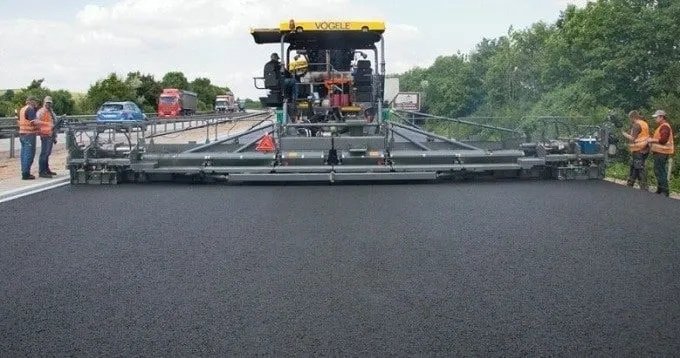Bituminous concrete is one of the most commonly used materials in the construction field. Often recognized by its other name, asphalt concrete, this composite material is indispensable in the construction and maintenance of our roads, parking lots, airports, and various other paved surfaces. At its core, bituminous concrete is a blend of mineral aggregates held together by bitumen, a sticky, viscous binder derived from petroleum refining. Its resilience, flexibility, and waterproofing properties make it an ideal choice for paving modern transportation networks.
The Composition and Production Process
Bituminous concrete is a mixture of bitumen and carefully selected aggregates, ranging from coarse to fine particles. Here’s a closer look at its makeup:
- Aggregates: These include a mixture of crushed stones, sand, and gravel. The quality, size, and grading of these aggregates are crucial, as they form the backbone of the material’s structure.
- Bitumen: The binder in the mix, bitumen, is a product extracted during the refining of crude oil. Its primary role is to coat the aggregates, ensuring that they stick together, which in turn imparts waterproofing and flexibility to the finished pavement.
- Mix Design: The design of the mix is tailored to the expected traffic load and environmental conditions. Engineers use specific ratios to balance durability, resistance to deformation, and longevity. The mixture is heated, blended, and then laid down on prepared surfaces where it is compacted to achieve a dense, resilient pavement.
The production process involves heating the bitumen and aggregates separately before mixing them at elevated temperatures. This ensures optimal coating and adhesion. After laying the mixture down, compaction techniques further improve the material’s strength and texture, resulting in a durable road surface. These properties enable pavements to resist temperature variations and endure heavy traffic loads.
Why Bituminous Concrete Remains Popular in Pavement Construction?
Several features offered by bituminous concrete make it a go-to solution for paving:
- Flexibility and Resilience: Unlike rigid materials such as concrete, the flexibility of bituminous concrete allows it to absorb stresses from thermal expansion, contraction, and dynamic loads from vehicles. This reduces the risk of cracking.
- Quick Installation: The heated mix can be laid down and compacted relatively quickly, reducing construction time and traffic disruption.
- Cost-Effectiveness: Its production and maintenance costs compare favourably with other paving materials, making it an economically smart choice for municipalities and contractors.
- Recyclability: Modern techniques allow old bituminous concrete to be recycled, reusing the aggregate and rejuvenating the bitumen. This sustainability advantage contributes to reducing waste and conserving resources.
Read Also- Superelevation in Highway Design
Applications of Bituminous Concrete in Infrastructure
The use of bituminous concrete is widespread, and its applications extend beyond the everyday roadway:
- Highways and Roadways: It offers great durability that makes it ideal for high-traffic roads, where flexibility is crucial for handling heavy loads.
- Airports and Runways: The material’s smooth finish and texture provide the necessary friction for safe take-offs and landings.
- Parking Areas and Pedestrian Walkways: Smooth, even surfaces contribute to the safety and accessibility of urban spaces.
- Industrial Paving: Heavy-duty areas like factory floors and loading zones benefit from the strength and resilience of bituminous concrete.
In each of these cases, the durability and maintenance ease of bituminous concrete help in reducing long-term operational costs. This also promises enhanced safety.
Challenges and Innovations
Despite its many advantages, bituminous concrete is not without challenges. Temperature sensitivity can lead to softening in hot weather and brittleness in cold conditions. However, ongoing research and technological advances are addressing these issues:
- Polymer-Modified Bitumen: By enhancing the bitumen with polymers, researchers have created a more temperature-resistant, flexible binder that improves overall pavement performance.
- Sustainable Practices: Efforts are underway to enhance the recyclability of bituminous concrete further while incorporating eco-friendly additives to reduce its environmental footprint.
- Innovative Mix Designs: Advanced mix design techniques using computer simulations help tailor bituminous concrete properties to specific environmental conditions and traffic profiles. This ensures longevity even under challenging conditions.
Final Thoughts
Bituminous concrete is changing the way we are paving our roads. It offers a blend of flexibility, durability, and cost-effectiveness, along with ongoing innovations in mix design and sustainability. It will remain a cornerstone of modern infrastructure. Whether you’re driving on a highway, landing on an airport runway, or simply parking in a lot, chances are you’re benefiting from the humble yet remarkable bituminous concrete.
Read Also-
Sustainable Building Materials: Shaping the Future of Construction
Glass Fiber Reinforced Concrete – Concrete Technology
What is Camber of the Road? Types and Benefits of Provideing Camber
